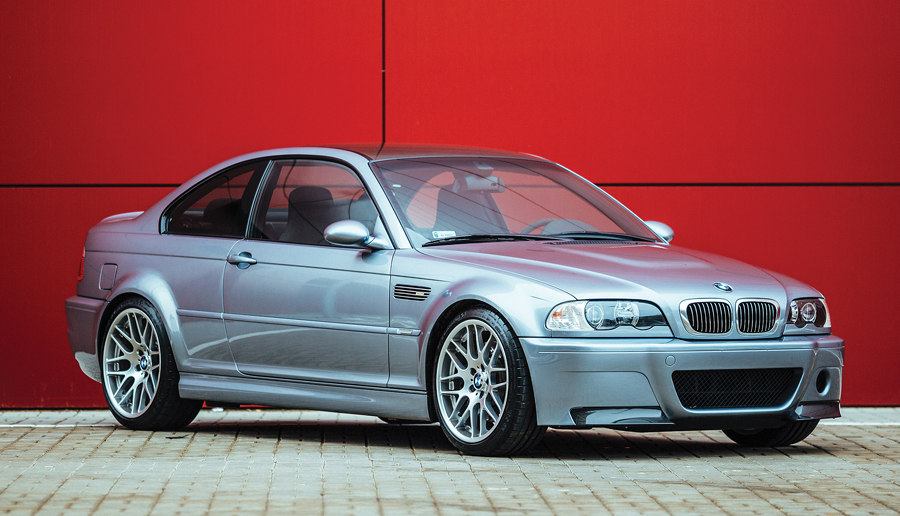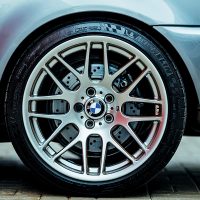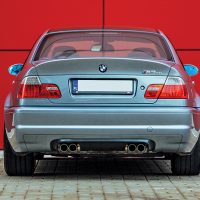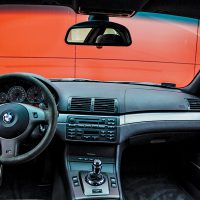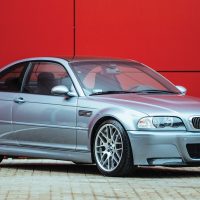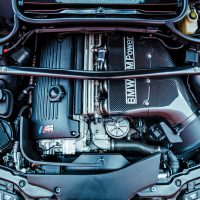- Delivered new to Japan
- One of 841 LHD M3 CSLs produced
- Accompanied by its original service book
SCM Analysis
Detailing
| Vehicle: | 2004 BMW M3 CSL |
| Years Produced: | 2004 |
| Number Produced: | 1,382 |
| Original List Price: | $115,000 |
| SCM Valuation: | $80,265 |
| Chassis Number Location: | VIN tag in front left corner of windshield |
| Engine Number Location: | Lower right-hand side of the block, just above oil pan |
| Club Info: | BMW Car Club of America (BMW CCA) |
| Website: | http://www.bmwcca.org |
| Alternatives: | 2001–06 Porsche 911 Turbo, 2004–07 Mercedes-Benz CL55 AMG, 2006–07 Aston Martin V8 Vantage |
| Investment Grade: | B |
This car, Lot 276, sold at $110,106, including buyer’s premium, at RM Sotheby’s Essen, DEU, sale on April 12, 2019.
Oh, to have been a fly on the wall at the meeting when BMW chiefs informed engineers that they would be the ones to build the E46 M3 CSL.
I picture a dozen or so of them sitting quietly in their white button-up shirts and gray slacks, hands politely folded on the conference room table. Some of them probably fiddled with their thin gold-frame glasses nervously, as they awaited the start of the meeting. Surely they must have sensed something significant was about to happen.
When the news was finally delivered, euphoria must have erupted in the room. But, you know, Teutonic levels of euphoria. Some gentle nodding, and perhaps a half-smile glinted across a few faces — pure German elation.
The engineers couldn’t waste much time celebrating, though. They had work to do. Their task was one of immense import.
After all, this was no regular M3 variant they were crafting. This would be just the second BMW in 40 years that was special enough to earn the Coupé Sport Leichtbau (CSL) badge.
The leading edge
The E46 M3 might well be the finest generation of M3 ever built — at least I think so. It’s no wonder, then, that the CSL badge was bestowed upon its most extreme variant.
The E46 M3 was born in that ideal era in between too little and too much technology.
By that I mean it was advanced enough to have prodigious power output, delightful chassis crispness, and just a soupçon of electronic nannies — enough to keep you (mostly) safe, as you rode the leading edge of your skill on the way to driving nirvana. And it achieved this without wholesale removing you from the driving process.
If the E46 was the best M3, then the 2004 M3 CSL was the best of the best.
In creating the CSL, Bimmer’s elite engineering brains went hog wild with weight savings. In fact, that is the greatest gift you give to a German: asking them to take something already otherworldly and make it lighter and more powerful.
I envision the engineers assigned to the CSL project spending sleepless nights lightly salivating in bed. They were undoubtedly afflicted with insomnia, as they joyously envisioned new ways to implement the use of lightweight plastics in a road-going sports coupe — one truly worthy of the CSL suffix.
In transforming the already uproarious E46 M3 into the CSL, BMW replaced the front air dam, roof, rear diffuser and interior trim with carbon-fiber-reinforced plastic. Sheet-molding compound was used for the trunk lid. The seats and bumper supports were formed from glass-fiber plastics. A rear windshield shaped from thinner glass was installed, and a panel of honeycomb sandwich paper replaced the trunk floor.
The efficient fiddling didn’t end there. The air conditioning was yanked. So, too, was the radio. Electric seat motors were also eliminated. An exhaust system formed from thinner metal was fitted, which was bolted to an uprated version of the S54 engine.
Lighter and faster
In the CSL, the 3.2-liter inline 6-cylinder churned out 360 horsepower and 273 ft-lb of torque — 22 extra horsepower over the standard M3 that year. The only transmission offered on the M3 CSL was BMW’s second-generation Sequential M Gearbox (SMG-II), which could dispatch shifts in 0.08 seconds.
As a result of the increased power output and weight savings — 243 pounds — the car whipped out a 0–62 mile-per-hour sprint in 4.9 seconds, 0–124 mph in 16.8 seconds — on to a top speed of 155 mph.
Bigger front brakes were bolted on, along with special springs and dampers. An M Track Mode was added to the Dynamic Stability Control to, as BMW put it, “achieve the highest conceivable standard of longitudinal and lateral acceleration on the race track.”
In short, BMW engineers ensured that no driver could ever dare blame this ultimate driving machine for a less-than-lightning-fast lap. Any track-day defeats fell squarely at the feet of the driver — not the CSL.
Seven months of CSL
Between June and December of 2003, 1,383 examples of the E46 M3 CSL were built, 841 of which were left-hand drive.
As for our subject left-hand-drive M3 CSL, it was originally delivered to Japan — a country with right-hand-drive vehicles. Go figure. Someone must have really wanted a CSL, even if it meant piloting a brand-new LHD car in an RHD traffic system.
Of the two colors offered on the CSL that year, Black Sapphire Metallic and Silver Grey Metallic, this one was finished in the latter. It also had its radio and air conditioning system retrofitted.
This no-cost creature-comfort option must have made the CSL much more livable. It is hardly in keeping with the spirit of the car, though.
This CSL spent 13 years in Japan prior to being transported to Poland in 2017. There, it was featured in the illustrious Polish magazine BMW Trends. In its life, it did just 20,600 miles before crossing the auction block in Essen. There, it sold for $110,106.
The top of a rising market
Prices of the E46 CSL have been climbing in recent years. Higher-mileage examples still transact below $50,000. However, nicer cars have been lapping over the $100,000 ledge, as this one did.
All things taken into account, including mileage, service history, and left-hand-drive layout, this one was well bought.
Likely, the value of these LHD examples will only skyrocket when they’re old enough to be imported into the U.S. — just 10 short years from now. So the new owner would be wise to let this one sit and accrue value.
That’d be a shame, though, because — as I understand it — a dozen-or-so Bimmer engineers lost a lot of sleep in making this car a thing of beauty to drive. ♦
(Introductory description courtesy of RM Sotheby’s.)
